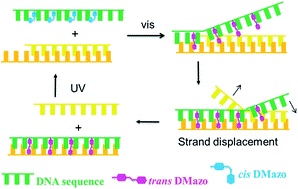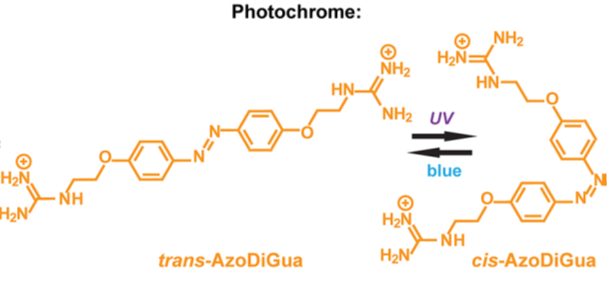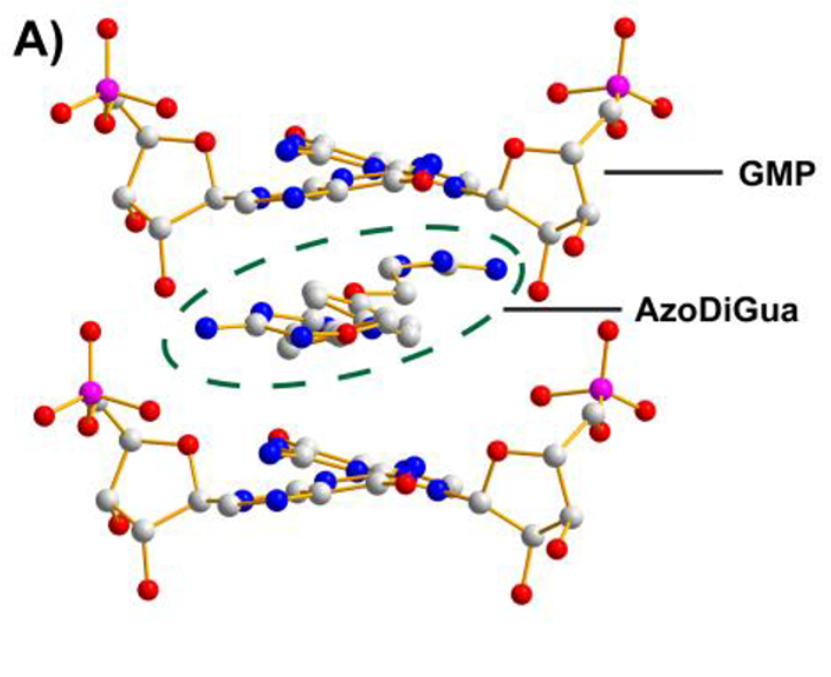Baigl Lab in ENS Paris proposed a photo switchable crystal made of GMP and an azobenzene compound. A simple way not only to build DNA crystals, but to control them with light. Upon blue light, the crystals form in rod needle like structures of up to 100 µm and can disassemble when exposed to UV light.
Publication:
Photoswitchable fluorescent crystals obtained by the photoreversible co-assembly of a nucleobase and an azobenzene intercalator
#
Azobenzene #DNACrystal #Photoswitchable #GMP

A blog post by Adrien Méry
After my engineering degree, I spent my PhD exploring the mechanical response of tissues using optogenetics and tissues engineering. This was also when I developed a passion for science communication and started working as a freelance scientific copywriter. Taking part to the Idylle blog is thus the perfect opportunity to combine both my love for pop-sci and cool research tools.
.png)

Figure 1 The crystal presented by Zhou can grow, assemble or disassemble with light and his fluorescent.
Taken From Zhou JACS 2019 (10.1021/jacs.9b02836)
Azobenzenes, the optical switches
The azobenzene is a molecule composed of two phenyl groups linked by a nitrogen-nitrogen double bound. Its structure gives it a particular property: upon exposure to UV light, its conformation would change from trans to cis, and reverse back when exposed to blue light. This property was exploited over the past decades to create light gated switches, in domains such as material science, optoelectronics, fluid actuation… but also vastly used in molecular biology. By introducing this moiety in a bigger molecule, it was used as artificial molecular motors, to displace DNA strand and design light gated ion channels.

Figure 2: Azobenzene compounds were used previously in different application. Here for instance, it was used to displace DNA strands. Taken from Kou RSC advances 2014 (10.1039/C4RA15449E).

Figure 3: Before the wide availability of optogenetics techniques, azobenzene compounds were used to design light-gates ion channels. Taken from Beharry Chem Society Reviews 2011 (10.1039/C1CS15023E).
A crystal that assembles and disassembles with light
In this work, the team combined GMPs with a DNA intercalant that contains an azobenzene moiety. Within minutes, a crystal assembles when exposed to blue light, and disassembles under UV light. The crystals thus obtained are 1D 100µm needles. Here, the authors proposed a proof of concept by gating permeability in a material with light: a layer of crystal loaded in an agarose membrane can be disassembled with light, thus increasing permeability. But more applications can be imagined: a photo-assembled material of this size could be used to shape structures that can be recomposed in minutes with light.

Figure 4: Once the compounds mix and the crystal formed once, the crystal can be locally disassembled and reassembled upon UV or blue light exposition. Taken From Zhou JACS 2019 (10.1021/jacs.9b02836).

Figure 5: The crystal can be locally patterned using light. This allows to control the permeability of an agarose gel using light. Taken From Zhou JACS 2019 (10.1021/jacs.9b02836).
How is this crystal assembling exactly?
The key component here is the azobenzene DNA intercalant, as the photosensitive part comes from its azobenzene moiety. In this case, the molecule in the trans conformation can create H bounds and pi-pi interactions with GMP. When the conformation is switched upon UV exposure, the interaction with the GMP is not favorable anymore, and the crystal decomposes. And this action can be reversed when the solution is exposed to blue light: the molecule reverses from its cis to trans conformation and the crystal reassembles.


Figure 6 The crystal is assembled From GMP and a DNA intercalant AZoDiGua. This compound includes an azobenzene moiety, which can change of conformation depending on the light it is exposed to. Taken From Zhou JACS 2019 (10.1021/jacs.9b02836).
In a nutshell
As a mechanobiologist and optogenetics fan, these long crystals rods that can be assembled and disassembled using light really caught my eye. You could definitely imagine using them to shape specific and changing environments for cells to interact with. Too bad the crystals only seem stable in an acidic environment (at least for now …).
References:
A. A. Beharry and G. A. Woolley, “Azobenzene photoswitches for biomolecules,” Chemical Society Reviews, vol. 40, no. 8. Royal Society of Chemistry (RSC), p. 4422, 2011. doi: 10.1039/c1cs15023e
B. Kou, J. Zhang, X. Huai, X. Liang, and S.-J. Xiao, “Light-driven reversible strand displacement using glycerol azobenzene inserted DNA” RSC Advances, vol. 5, no. 7. Royal Society of Chemistry (RSC), pp. 5055–5058, 2015. doi: 10.1039/c4ra15449e
MORE LIFE SCIENCE TOOLS TO FOLLOW
You want the latest on life science tools to follow, test and more?